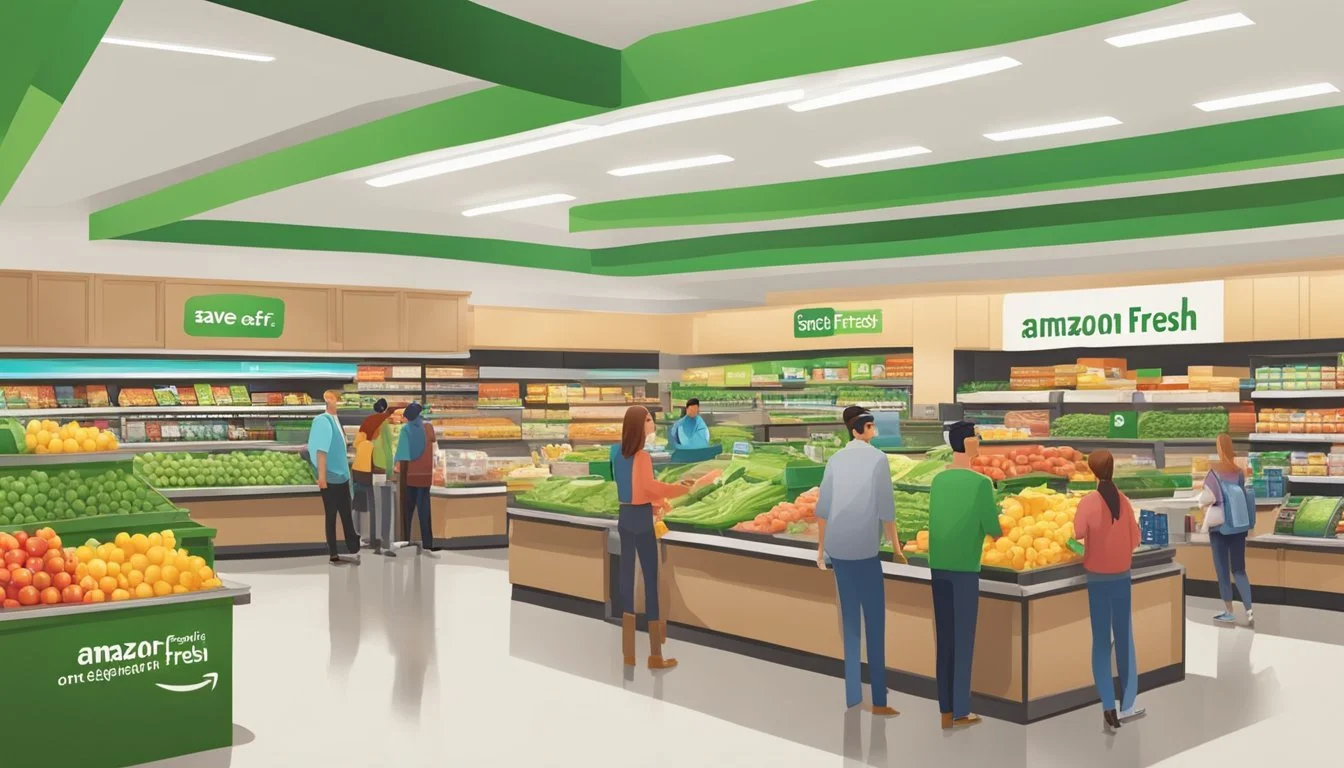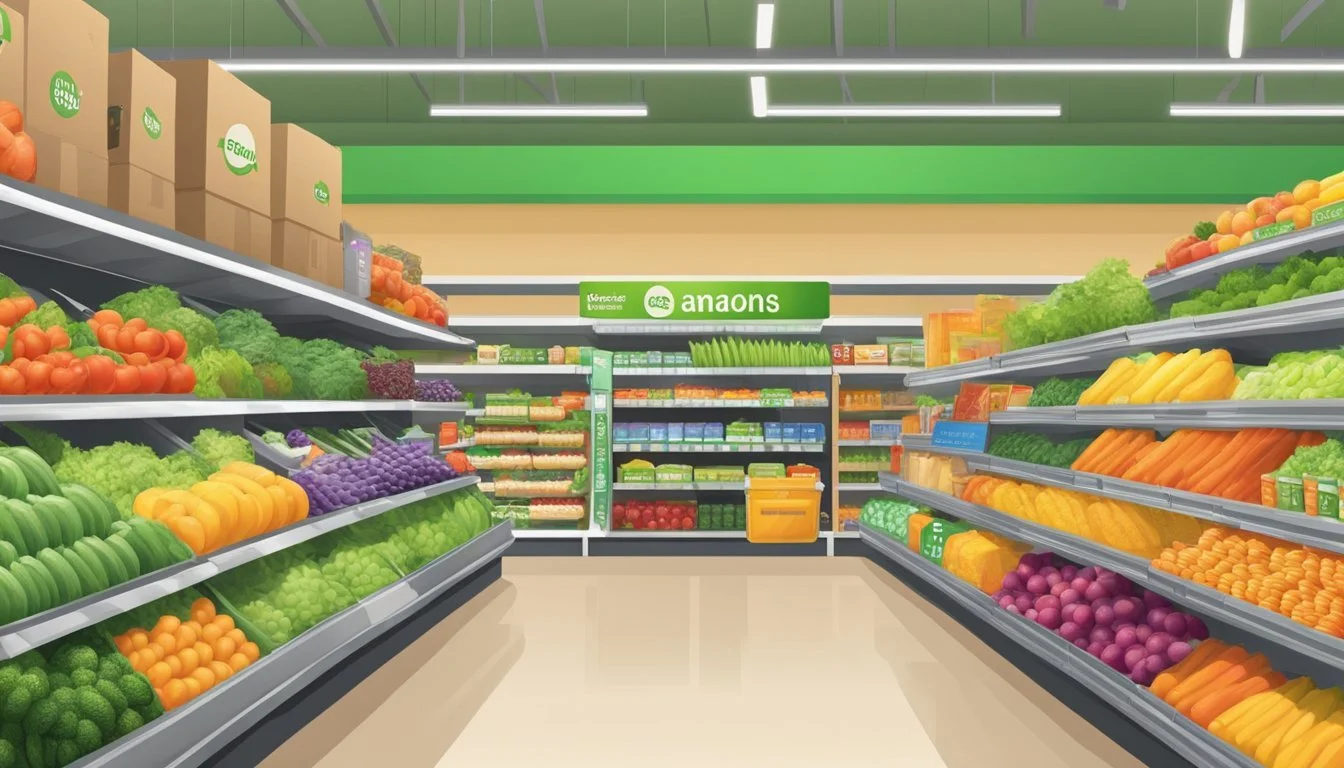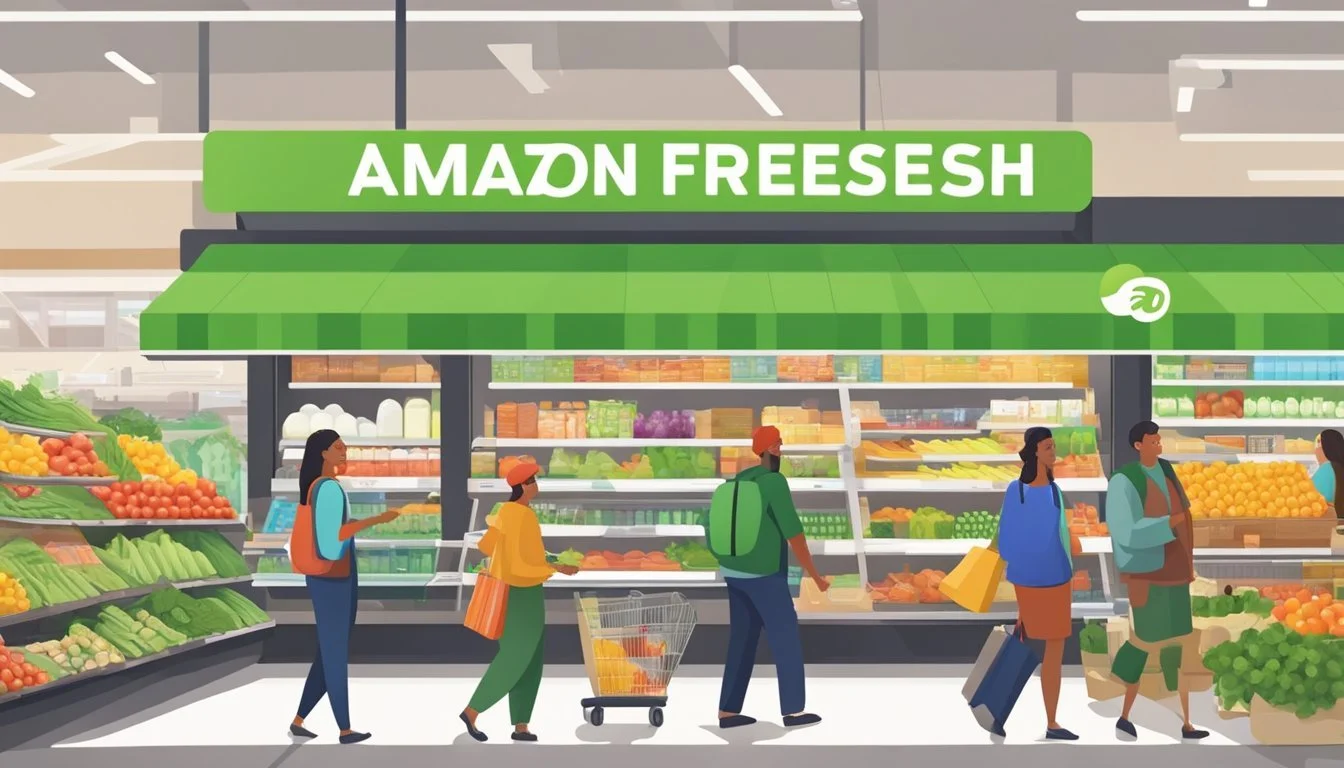Amazon Fresh vs Save Mart
A Comprehensive Comparison of Price, Quality, and Convenience
Grocery shopping has become more convenient with online options like Amazon Fresh competing against traditional supermarkets. Many consumers are wondering how Amazon Fresh compares to established chains like Save Mart in terms of pricing, selection, and overall value.
Amazon Fresh tends to offer competitive prices on many items compared to traditional grocery stores, with some studies finding their prices up to 16% lower on average. However, the price differences can vary depending on specific products and locations. Amazon Fresh may have an edge in convenience with its delivery options, while Save Mart provides the traditional in-store shopping experience some customers prefer.
Both Amazon Fresh and Save Mart have their strengths and weaknesses. Amazon Fresh excels in digital convenience and often beats traditional stores on packaged goods pricing. Save Mart, on the other hand, may offer advantages in fresh produce selection and the ability to hand-pick items. The better choice ultimately depends on individual shopping preferences and priorities.
Overview of Amazon Fresh
Amazon Fresh is Amazon's grocery delivery and pickup service, offering a wide selection of fresh produce, meats, pantry staples, and household items. It combines the convenience of online shopping with the quality of a traditional supermarket.
History and Business Model
Amazon Fresh launched in 2007 as a pilot program in Seattle. It gradually expanded to other major U.S. cities and select international markets. The service is available exclusively to Amazon Prime members in most areas.
Amazon Fresh operates both as an online platform and through physical stores. Customers can order groceries for home delivery or pickup at designated locations. The service emphasizes freshness, competitive pricing, and fast delivery options.
In recent years, Amazon has invested heavily in its grocery infrastructure, including the acquisition of Whole Foods Market in 2017. This move strengthened Amazon Fresh's supply chain and expanded its product offerings.
Amazon Fresh leverages advanced technology to optimize inventory management and order fulfillment. The service uses algorithms to predict demand and minimize food waste.
Overview of Save Mart
Save Mart is a regional grocery store chain primarily operating in California and Nevada. The company focuses on providing quality products and exceptional customer service to its local communities.
History and Core Values
Save Mart Supermarkets was founded in 1952 by Nick Tocco and Bob Piccinini in Modesto, California. The company started as a single store and gradually expanded throughout Northern California and Northern Nevada.
Save Mart's core values revolve around customer satisfaction, community involvement, and employee development. The company emphasizes fresh, high-quality products and strives to support local farmers and producers.
In recent years, Save Mart has embraced technological advancements to enhance the shopping experience. The company partnered with Amazon to offer grocery delivery services, providing customers with more convenient options.
Save Mart operates under several banners, including Save Mart, Lucky, and FoodMaxx. These diverse store formats cater to different customer segments and preferences.
The company remains committed to its local roots and actively participates in community initiatives. Save Mart supports various charitable organizations and sponsors local events to strengthen its ties with the neighborhoods it serves.
Scope and Scale of Operations
Amazon Fresh and Save Mart operate at different scales with distinct geographical footprints and product offerings. Their contrasting approaches shape the shopping experiences they provide to customers.
Geographical Presence in the US
Amazon Fresh has rapidly expanded its physical store presence since launching in 2020. The company currently operates 44 stores across several US states, primarily concentrated in urban areas and technology hubs. This relatively small but growing footprint allows Amazon to test and refine its grocery store concept.
Save Mart, in contrast, has a more established regional presence. The company runs over 200 stores across California and Nevada under various banners including Save Mart, Lucky, and FoodMaxx. This larger network of locations provides Save Mart with deeper penetration in specific markets.
Variety and Range of Products Offered
Amazon Fresh emphasizes a curated selection of groceries, focusing on everyday essentials and popular brands. Their stores typically stock around 10,000 items, including fresh produce, meat, seafood, and prepared foods. Amazon's private label offerings feature prominently alongside national brands.
Save Mart provides a broader product range, often carrying 20,000 to 30,000 items per store. This includes an extensive selection of local and regional products, catering to diverse customer preferences. Save Mart's larger stores allow for wider aisles and more variety in categories like produce, dairy, and specialty foods.
Both retailers offer organic options and cater to various dietary needs. However, Save Mart's larger format stores generally provide more choice within each product category.
Pricing and Membership
Amazon Fresh and Save Mart offer different pricing structures and membership options for grocery shoppers. Both stores aim to provide value through competitive pricing and additional perks for members.
Comparing Membership Costs
Amazon Fresh is available to Amazon Prime members, which costs $139 per year or $14.99 per month. This membership includes access to other Amazon services like Prime Video and free shipping on eligible items. Save Mart does not have a paid membership program.
Amazon Prime members receive free delivery on Amazon Fresh orders over $35 in eligible areas. Orders under $35 incur a delivery fee. Save Mart partners with Instacart for delivery, which charges separate fees based on order size and delivery time.
Membership Benefits and Exclusive Offers
Amazon Prime members enjoy exclusive discounts on select items at Amazon Fresh and Whole Foods Market. These deals change regularly and can offer significant savings on groceries. Prime members also earn 5% cash back when using the Amazon Prime Rewards Visa Signature Card at Amazon Fresh.
Save Mart offers a free rewards program called Save Smart. Members earn points on purchases and receive personalized digital coupons. Save Mart also provides weekly ad specials and digital coupons available to all shoppers, regardless of membership status.
Both stores frequently run promotional deals and seasonal discounts. Amazon Fresh tends to have more frequent and varied offers due to its connection with the broader Amazon ecosystem.
Shopping Experience
Amazon Fresh and Save Mart offer distinct shopping experiences tailored to different customer preferences. Both provide unique advantages in terms of convenience and accessibility.
Convenience of Shopping
Amazon Fresh prioritizes convenience through its online platform and mobile app. Customers can browse products, create shopping lists, and place orders from anywhere at any time. The service offers same-day or next-day delivery options, eliminating the need to visit a physical store.
Save Mart focuses on traditional in-store shopping with some digital enhancements. Their stores are typically open extended hours, allowing customers to shop at their convenience. Save Mart also offers a mobile app for creating shopping lists and accessing digital coupons.
In-store vs. Online Shopping Experience
Save Mart provides a hands-on shopping experience. Customers can personally select produce, inspect items, and make spontaneous purchases. The stores often feature specialty departments like bakeries and delis.
Amazon Fresh's online interface allows for easy product searches and filters. Shoppers can quickly compare prices and read product reviews. The platform remembers past purchases, making reordering simple. However, customers cannot physically examine items before purchase.
Both retailers offer tools to enhance the shopping experience. Save Mart provides in-store product locators and self-checkout options. Amazon Fresh utilizes AI-powered recommendations and allows customers to track their order status in real-time.
Delivery Options
Amazon Fresh and Save Mart offer different grocery delivery services to meet customer needs. Both aim to provide convenient options, but their approaches vary in terms of speed, cost, and availability.
Speed and Reliability of Delivery
Amazon Fresh provides same-day delivery in many areas, often within a 2-hour window. Prime members can schedule deliveries at no extra cost. The service is known for its reliability and punctuality.
Save Mart partners with Instacart for grocery delivery. Customers can receive orders within 2 hours or schedule deliveries up to 5 days in advance. Instacart shoppers pick and deliver items, which may lead to occasional substitutions or out-of-stock issues.
Both services allow customers to track their orders in real-time and receive notifications about delays or changes.
Delivery Costs and Tips
Amazon Fresh offers free delivery on orders over $35 for Prime members. Orders under $35 incur a $9.99 delivery fee. There's no need to tip Amazon Fresh drivers, as they receive an hourly wage.
Save Mart's delivery through Instacart charges a delivery fee, typically around $3.99 for orders over $35. Smaller orders may have higher fees. Instacart also adds a service fee of about 5% to each order.
Tipping is customary for Instacart shoppers, with 15-20% of the order total being standard. Customers can adjust tips after delivery based on service quality.
Product Quality and Availability
Amazon Fresh and Save Mart offer different product selections and quality levels. Both stores aim to provide fresh groceries and household essentials, but their approaches vary in terms of sourcing and brand availability.
Freshness and Quality of Produce
Amazon Fresh emphasizes high-quality produce, often sourcing from local farms and Whole Foods Market suppliers. Their fruits and vegetables are generally fresh and well-packaged to maintain quality during delivery.
Save Mart focuses on providing affordable produce options. While their quality can be good, it may not always match Amazon Fresh's consistency. Save Mart stores allow customers to personally select their produce, which some shoppers prefer.
Both retailers offer organic options, with Amazon Fresh typically having a wider organic selection due to its Whole Foods connection.
Brand Availability and Exclusive Products
Amazon Fresh carries many national brands alongside its own private labels like Happy Belly and Amazon Fresh Select. It also offers exclusive access to Whole Foods Market products.
Save Mart stocks a mix of national brands and regional favorites. Their selection may include more local products specific to their store locations.
Amazon Fresh tends to have a broader range of specialty and gourmet items. Save Mart generally focuses on mainstream brands and everyday essentials.
Both stores carry common household items, but Amazon Fresh often has a more extensive selection of non-grocery products.
Additional Perks and Services
Amazon Fresh and Save Mart offer unique benefits beyond groceries. These extras can enhance the shopping experience and provide added value for customers.
Entertainment and Additional Benefits
Amazon Fresh, as part of the Amazon Prime ecosystem, provides a suite of entertainment options. Prime Video offers a vast library of movies, TV shows, and original content. Members can stream thousands of songs ad-free with Prime Music. Prime Reading gives access to a rotating selection of e-books, magazines, and comics.
Prime Try Before You Buy allows customers to order clothing items, try them on at home, and only pay for what they keep. This service extends the convenience of online shopping to fashion purchases.
Save Mart focuses on in-store perks. Many locations feature wine tasting events, cooking demonstrations, and seasonal activities for families. Some stores have expanded food service options, including hot bars and made-to-order sandwiches.
Rewards Programs and Credit Card Offers
Amazon offers the Amazon Prime Rewards Visa Signature Card. Cardholders earn 5% back on Amazon.com and Whole Foods Market purchases, 2% back at restaurants, gas stations, and drugstores, and 1% back on all other purchases.
Prime members can take advantage of exclusive deals during Amazon Prime Day, a multi-day shopping event featuring significant discounts across various categories.
Save Mart's rewards program allows customers to earn points on purchases, which can be redeemed for discounts on future shopping trips. The company occasionally partners with local businesses to offer additional savings and promotions to reward members.
Both retailers provide digital coupons through their respective apps, helping customers save money on their grocery purchases.
Customer Satisfaction and Loyalty
Amazon Fresh and Save Mart prioritize customer satisfaction to build loyalty. Both retailers employ strategies to encourage repeat business and positive feedback.
Customer Reviews and Feedback
Amazon Fresh leverages its extensive online platform to gather customer reviews. Shoppers can rate products and leave detailed feedback, helping others make informed decisions. This transparency builds trust among consumers.
Save Mart, with its physical store presence, relies more on in-person interactions and local reputation. They often conduct customer surveys and encourage feedback through social media channels.
Both stores address customer concerns promptly. Amazon Fresh offers easy returns and refunds for unsatisfactory items. Save Mart's customer service representatives are trained to resolve issues on the spot.
Brand Loyalty and Repeat Business
Amazon Fresh benefits from its Prime membership program, offering exclusive deals and free delivery to encourage loyalty. Their data-driven approach allows personalized recommendations, increasing the likelihood of repeat purchases.
Save Mart focuses on community engagement and local partnerships to foster loyalty. They offer store-specific loyalty programs with points systems and personalized discounts.
Both retailers use mobile apps to enhance the shopping experience. Amazon Fresh's app integrates seamlessly with other Amazon services. Save Mart's app provides digital coupons and weekly ad previews.
Reliable inventory management is crucial for both stores to maintain customer trust. Amazon Fresh's vast network ensures product availability, while Save Mart's local focus allows for quick restocking of popular items.
Comparative Analysis
Amazon Fresh and Save Mart offer distinct shopping experiences, each with its own advantages and drawbacks. Their pricing strategies and product offerings cater to different consumer needs and preferences in today's evolving grocery market.
Pros and Cons of Each Store
Amazon Fresh excels in convenience and technology integration. It offers contactless shopping with smart carts and digital price tags. The store's seamless integration with Prime membership provides added benefits.
Save Mart focuses on traditional grocery shopping with a emphasis on local produce and community engagement. It offers a familiar layout and personalized customer service.
Both stores struggle with inventory management. Amazon Fresh sometimes faces out-of-stock issues, while Save Mart may have limited variety in certain product categories.
Cost Effectiveness and Value for Money
Amazon Fresh generally offers competitive prices, especially on household staples and packaged goods. Prime members enjoy additional discounts and free delivery on orders over a certain threshold.
Save Mart provides value through its loyalty program and weekly specials. It often has lower prices on fresh produce and meat due to local sourcing.
Comparing overall basket costs, Amazon Fresh tends to be slightly cheaper for a typical grocery trip. However, Save Mart can be more cost-effective for shoppers who take advantage of sales and loyalty rewards.
Market Trends and Consumer Preferences
Consumer behavior is shifting towards convenience and digital integration. Amazon Fresh capitalizes on this trend with its tech-forward approach and online-offline synergy.
Save Mart appeals to shoppers who value community connection and supporting local businesses. It aligns with the growing interest in sustainability and locally sourced products.
Both stores are adapting to increased demand for organic and health-focused options. Amazon Fresh leverages data analytics to tailor its offerings, while Save Mart emphasizes its relationships with local farmers and producers.
The Impact of Competitors
Amazon Fresh and Save Mart face stiff competition in the grocery market. Their strategies and market positions are shaped by rivals like Walmart and Kroger. Both companies must continuously innovate to stay relevant.
Market Position Relative to Competitors
Amazon Fresh leverages its parent company's vast resources and technology to compete. It offers convenient online ordering and fast delivery options. Save Mart focuses on regional markets, emphasizing local products and community connections.
Walmart remains the dominant force in grocery retail. Its massive store network and low prices pose challenges for both Amazon Fresh and Save Mart. Kroger competes through its extensive private label offerings and data-driven customer insights.
Amazon Fresh's prices are often competitive with or lower than traditional grocers. A study found Amazon's grocery prices averaged 16% below competitors. Save Mart aims to differentiate through quality produce and personalized service.
Adaptation and Innovation in Response to Competition
Amazon Fresh continually refines its technology and logistics. It experiments with cashierless stores and voice ordering through Alexa. The company also expands its physical presence, now operating 29 Amazon Fresh supermarkets in six states.
Save Mart focuses on enhancing in-store experiences. It introduces features like wine tasting areas and made-to-order food stations. The company also invests in e-commerce capabilities to compete with online rivals.
Both retailers expand their store brand offerings to compete with name brands and other private labels. Amazon's 365 brand and Save Mart's Sun Harvest line provide value alternatives to national brands.
Competitors' moves drive constant innovation. Walmart's curbside pickup service prompted similar offerings from Amazon Fresh and Save Mart. Kroger's data analytics push spurred investments in personalization by both companies.
Future Outlook
The grocery market is poised for significant changes in the coming years. Amazon Fresh and Save Mart will need to adapt their strategies to stay competitive and meet evolving consumer demands.
Predictions for the Grocery Market
E-commerce will continue to grow, with online grocery sales expected to reach 20% of the market by 2026. Sustainability will become a key focus, driving demand for eco-friendly packaging and locally sourced products.
Artificial intelligence and automation will reshape store operations. Retailers will invest in advanced analytics to personalize shopping experiences and optimize inventory management.
Health-conscious consumers will seek more organic and plant-based options. Convenience will remain crucial, with prepared meals and grab-and-go items gaining popularity.
Strategies for Future Growth and Development
Amazon Fresh will likely leverage its technological edge to enhance the in-store experience. The company may expand its Just Walk Out technology and introduce more innovative features to streamline shopping.
Save Mart could focus on strengthening its community ties and emphasizing local products. Investing in digital capabilities and expanding delivery options will be essential to compete with online giants.
Both retailers will need to prioritize employee training and development to adapt to new technologies. Sustainability initiatives, such as reducing food waste and implementing energy-efficient practices, will become increasingly important.
Research into consumer preferences and market trends will guide product selection and store layouts. Partnerships with local suppliers and food startups could provide a competitive advantage in offering unique, sought-after products.










